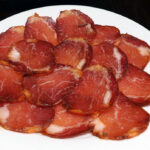The image of the Iberian pig and its derivatives is surrounded by numerous beliefs that can sometimes confuse consumers. This article addresses some of the most common myths and contrasts them with the reality based on tradition, production processes and quality certifications that characterise these products.
Myth 1: “All Iberian pigs are the same”.
Reality: The diversity in the feeding and management of the Iberian pig makes a noticeable difference in the final product. For example, acorn-fed Iberian ham comes from animals reared free-range in dehesas, where they feed mainly on acorns and natural grasses, which influences fat infiltration and the aromatic profile. In contrast, Iberian cebo ham is obtained from animals reared on farms with a feed-based diet, which results in a different texture and flavour. The classification by means of coloured seals -black, red, green and white- makes it easier to distinguish between these categories, guaranteeing consumers the information they need to choose according to their preferences.
Myth 2: “The curing process is the same for all products”.
Reality: Although curing is an essential process in the production of ham and other Iberian products, each category has specific techniques adapted to the piece in question. For example, in the case of Iberian ham, drying and maturing in natural cellars is carried out under controlled conditions of temperature and humidity, which allows for the development of a unique flavour and texture. In other products, such as cured pork loin or sausages, the salting and stuffing process is adapted to the nature of the meat and the desired end product, without losing sight of the tradition and quality that distinguish the Iberian pig.
Myth 3: “Higher price always means better quality”.
Reality: While it is true that products made from acorn-fed Iberian pigs tend to command a higher price due to the dehesa rearing and extensive curing process, this does not mean that cebo products are of lower quality. Each category offers different characteristics and benefits. The key is to know the labelling system and the certifications that guarantee the origin and quality of the product. Traceability and rigorous control at each stage of production ensure that, regardless of the price, the consumer receives a product that is authentic and conforms to established standards.
Myth 4: “The consumption of Iberian products is only an occasional luxury”.
Reality: Although Iberian ham and other derivatives of the Iberian pig are considered gourmet products, there are options for different occasions and budgets. The variety of presentations, from sausages to fresh pieces, makes it possible to integrate these products into the daily diet without compromising quality. In addition, the growing demand and expansion of the industry has boosted the availability of these products in various formats, making the authentic taste of Iberian pork accessible to a wider public.
Myth 5: “Tradition prevents innovation in Iberian production”.
Realidad: La industria del cerdo ibérico combina con éxito técnicas tradicionales y avances tecnológicos. Desde el control digital de la trazabilidad hasta la incorporación de códigos QR en el etiquetado, las innovaciones permiten mantener la autenticidad del producto mientras se mejora la eficiencia y la transparencia en la cadena de producción. Estas mejoras no solo garantizan la calidad, sino que también refuerzan el compromiso con la sostenibilidad y la protección del patrimonio gastronómico español.





